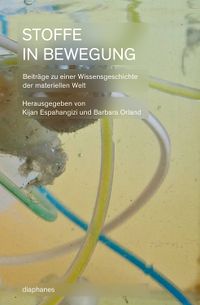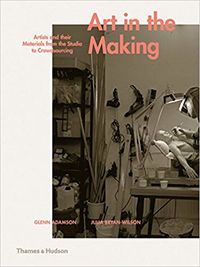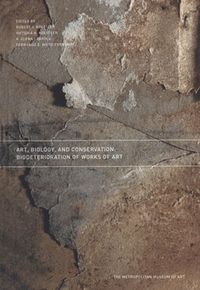Materiathek Bücher: Unterschied zwischen den Versionen
Aus exmediawiki
| Zeile 19: | Zeile 19: | ||
<small> https://www.diaphanes.de/buch/detail/2416 </small> | <small> https://www.diaphanes.de/buch/detail/2416 </small> | ||
| + | |||
| + | ---- | ||
| + | |||
| + | == [[Art in the Making]] == | ||
| + | Artists and their Materials from the Studio to Crowdsourcing | ||
| + | |||
| + | [[Datei:Art in the Making.jpg|200px|miniatur]] | ||
| + | |||
| + | |||
| + | AutorIn: Glenn Adamson, Julia Bryan-Wilson <br> | ||
| + | Jahr: 2014 <br> | ||
| + | Verlag: Thames & Hudson <br> | ||
| + | Signatur: KUN C.0 - 309 <br> | ||
| + | |||
| + | <small> http://bibkatalog.khm.de/F/R4Q91FNXSF8D6THM2VA1LAF2CGXRNHQUMHSS1RDLNUQLEG7L59-25077?func=full-set-set&set_number=655688&set_entry=000001&format=999 </small> | ||
| + | |||
| + | Today, artists are able to create using multiple methods of production from painting to digital technologies to crowdsourcing some of which would have been unheard of just a few decades ago. Yet, even as our means of making art become more extraordinary and diverse, they are almost never addressed in their specificity. While critics and viewers tend to focus on the finished products we see in museums and galleries, authors Glenn Adamson and Julia Bryan-Wilson argue that the materials and processes behind the scenes used to make artworks are also vital to current considerations of authorship and to understanding the economic and social contexts from which art emerges.This wide-ranging exploration of different methods and media in art since the 1950s includes nine chapters that focus on individual processes of making: Painting, Woodworking, Building, Performing, Tooling Up, Cashing In, Fabricating, Digitizing, and Crowdsourcing. Detailed examples are interwoven with the discussion, including visuals that reveal the intricacies of techniques and materials. Artists featured include Ai Weiwei, Alice Aycock, Isa Genzken, Los Carpinteros, Paul Pfeiffer, Doris Salcedo, Santiago Sierra, and Rachel Whiteread. | ||
| + | |||
| + | <small> https://www.amazon.de/Art-Making-Artists-Materials-Crowdsourcing/dp/0500239339 </small> <br> | ||
| + | |||
| + | From painting to digital technologies to crowdsourcing, over the last few decades the means of making artworks have become more extraordinary and diverse. Yet we rarely consider the implications of how art is made. | ||
| + | In this wide-ranging exploration of methods and media in art since the 1950s Glenn Adamson and Julia Bryan-Wilson take the reader behind the scenes of the studio, the factory, and other sites where art is created. They show how the materials and processes used by artists are vital to considerations of authorship, and to understanding the economic and social contexts from which art emerges. | ||
| + | Art in the Making focuses on the intersection of thinking and making through chapters focusing on a particular process: painting, woodworking, building, performing, tooling up, cashing in, fabricating, digitizing and crowdsourcing. Discussions of broader themes are woven together with detailed examples and visuals, revealing the logic involved in the choice of techniques and materials. | ||
| + | Artists featured include Alice Aycock, Judy Chicago, Isa Genzken, Los Carpinteros, Paul Pfeiffer, Doris Salcedo, Santiago Sierra and Rachel Whiteread. | ||
| + | |||
| + | <small> https://thamesandhudson.com/how-is-contemporary-art-made-9780500239339 </small> | ||
| + | |||
| + | ---- | ||
| + | |||
| + | == [[Art, Biology & Conversation]] == | ||
| + | Biodeterioration of Works of Art | ||
| + | |||
| + | [[Datei:Art biology and conservation.jpg|200px|miniatur]] | ||
| + | |||
| + | AutorIn: Koestler, Robert J., Victoria H. Koestler, A. Elena Charola, and Fernando E. Nieto-Fernandez <br> | ||
| + | Jahr: 2004 <br> | ||
| + | Verlag: Yale Univ. Press <br> | ||
| + | Signatur: KUN C.7 - 65 <br> | ||
| + | |||
| + | <small> http://bibkatalog.khm.de/F/R4Q91FNXSF8D6THM2VA1LAF2CGXRNHQUMHSS1RDLNUQLEG7L59-25080?func=full-set-set&set_number=655688&set_entry=000002&format=999 </small> | ||
| + | |||
| + | |||
| + | The interface of art, science, and conservation is an exciting place. That's what we at the Metropolitan Museum of Art discovered in June 2002 when we hosted a three-day symposium that brought these areas together. The first such conference ever held at the Met, the Art, Biology, and Conservation 2002 meeting provided an opportunity for close to 40 scientists and conservators to present their latest research on the interactions of microbes and art, and to offer approaches to counter the effects of biodeterioration. | ||
| + | As I noted at the time, no work of art is immune to microbial attack. Microbes, being cosmopolitan, are a threat to art collections worldwide, as they are always present in the environment, lying dormant, and waiting for the right conditions to occur so they can flourish. Such conditions include subtle environment changes, such as a temporary increase in moisture level, as well as major events, such as a water leak; both can foster an infestation within just hours. Whether this leads to serious damage depends on many factors, including the material composition of the art, the amount of water present, the species of microbe on the art, and how long conditions are favorable for growth. Once such mishaps occur, the work of scientists and conservators becomes vital, as they strive to protect our often fragile cultural heritage. | ||
| + | The papers in this volume detail the work of the select group of biologists and conservators that came together at ABC2002 to show how they are addressing these concerns. A wonderfully diverse group, they had in common a desire to preserve the historic and the beautiful, the skills to do so, and an excitement about the whole process. I think that excitement comes through in this volume as well. | ||
| + | |||
| + | |||
| + | <small> https://www.metmuseum.org/art/metpublications/Art_Biology_and_Conservation_Biodeterioration_of_Works_of_Art </small> | ||
---- | ---- | ||
Version vom 2. Juli 2019, 15:59 Uhr
Inhaltsverzeichnis
Stoffe in Bewegung
Beiträge zur einer Wissensgeschichte der materiellen Welt
AutorIn: Kijan Espahangizi
Jahr: 2014
Verlag: Diaphenes
Signatur: GES B.3.3 - 32
Alles ist im Fluss – diese antike Weisheit feiert im durchglobalisierten Weltgeschehen fröhliche Urstände. Mobilität und Wandel sind die kategorischen Imperative der Zeit. Auch Stoffe bewegen sich rastlos über den Erdball, ebenso wie durch unsere Körper, werden fortlaufend umgestaltet und konstituieren so die materielle Welt, wie wir sie erleben. Ausgehend von diesem Befund wird eine Wissensgeschichte dieser materiellen Welt anvisiert, die nicht Strukturen, sondern stoffliche Überführungen und Umwandlungen – räumlich, zeitlich und substanziell – ins Zentrum rückt. Ohne der Versuchung zu erliegen, die Physikochemie mit ihrem elementaren Baukastenprinzip der Materie oder theoretische Figurationen aktueller Diskurse – Stoffkreislauf, Zirkulation, Stoffwechsel, Materialfluss – als historische Apriori zu setzen, entwickeln die Beiträge eine von Prozessen und Bewegungen ausgehende Natur- und Kulturgeschichte der materiellen Welt.
https://www.diaphanes.de/buch/detail/2416
Art in the Making
Artists and their Materials from the Studio to Crowdsourcing
AutorIn: Glenn Adamson, Julia Bryan-Wilson
Jahr: 2014
Verlag: Thames & Hudson
Signatur: KUN C.0 - 309
Today, artists are able to create using multiple methods of production from painting to digital technologies to crowdsourcing some of which would have been unheard of just a few decades ago. Yet, even as our means of making art become more extraordinary and diverse, they are almost never addressed in their specificity. While critics and viewers tend to focus on the finished products we see in museums and galleries, authors Glenn Adamson and Julia Bryan-Wilson argue that the materials and processes behind the scenes used to make artworks are also vital to current considerations of authorship and to understanding the economic and social contexts from which art emerges.This wide-ranging exploration of different methods and media in art since the 1950s includes nine chapters that focus on individual processes of making: Painting, Woodworking, Building, Performing, Tooling Up, Cashing In, Fabricating, Digitizing, and Crowdsourcing. Detailed examples are interwoven with the discussion, including visuals that reveal the intricacies of techniques and materials. Artists featured include Ai Weiwei, Alice Aycock, Isa Genzken, Los Carpinteros, Paul Pfeiffer, Doris Salcedo, Santiago Sierra, and Rachel Whiteread.
https://www.amazon.de/Art-Making-Artists-Materials-Crowdsourcing/dp/0500239339
From painting to digital technologies to crowdsourcing, over the last few decades the means of making artworks have become more extraordinary and diverse. Yet we rarely consider the implications of how art is made. In this wide-ranging exploration of methods and media in art since the 1950s Glenn Adamson and Julia Bryan-Wilson take the reader behind the scenes of the studio, the factory, and other sites where art is created. They show how the materials and processes used by artists are vital to considerations of authorship, and to understanding the economic and social contexts from which art emerges. Art in the Making focuses on the intersection of thinking and making through chapters focusing on a particular process: painting, woodworking, building, performing, tooling up, cashing in, fabricating, digitizing and crowdsourcing. Discussions of broader themes are woven together with detailed examples and visuals, revealing the logic involved in the choice of techniques and materials. Artists featured include Alice Aycock, Judy Chicago, Isa Genzken, Los Carpinteros, Paul Pfeiffer, Doris Salcedo, Santiago Sierra and Rachel Whiteread.
https://thamesandhudson.com/how-is-contemporary-art-made-9780500239339
Art, Biology & Conversation
Biodeterioration of Works of Art
AutorIn: Koestler, Robert J., Victoria H. Koestler, A. Elena Charola, and Fernando E. Nieto-Fernandez
Jahr: 2004
Verlag: Yale Univ. Press
Signatur: KUN C.7 - 65
The interface of art, science, and conservation is an exciting place. That's what we at the Metropolitan Museum of Art discovered in June 2002 when we hosted a three-day symposium that brought these areas together. The first such conference ever held at the Met, the Art, Biology, and Conservation 2002 meeting provided an opportunity for close to 40 scientists and conservators to present their latest research on the interactions of microbes and art, and to offer approaches to counter the effects of biodeterioration.
As I noted at the time, no work of art is immune to microbial attack. Microbes, being cosmopolitan, are a threat to art collections worldwide, as they are always present in the environment, lying dormant, and waiting for the right conditions to occur so they can flourish. Such conditions include subtle environment changes, such as a temporary increase in moisture level, as well as major events, such as a water leak; both can foster an infestation within just hours. Whether this leads to serious damage depends on many factors, including the material composition of the art, the amount of water present, the species of microbe on the art, and how long conditions are favorable for growth. Once such mishaps occur, the work of scientists and conservators becomes vital, as they strive to protect our often fragile cultural heritage.
The papers in this volume detail the work of the select group of biologists and conservators that came together at ABC2002 to show how they are addressing these concerns. A wonderfully diverse group, they had in common a desire to preserve the historic and the beautiful, the skills to do so, and an excitement about the whole process. I think that excitement comes through in this volume as well.
Art in the Making
Artists and their Materials from the Studio to Crowdsourcing
AutorIn: Glenn Adamson, Julia Bryan-Wilson
Jahr: 2014
Verlag: Thames & Hudson
Signatur: KUN C.0 - 309
Today, artists are able to create using multiple methods of production from painting to digital technologies to crowdsourcing some of which would have been unheard of just a few decades ago. Yet, even as our means of making art become more extraordinary and diverse, they are almost never addressed in their specificity. While critics and viewers tend to focus on the finished products we see in museums and galleries, authors Glenn Adamson and Julia Bryan-Wilson argue that the materials and processes behind the scenes used to make artworks are also vital to current considerations of authorship and to understanding the economic and social contexts from which art emerges.This wide-ranging exploration of different methods and media in art since the 1950s includes nine chapters that focus on individual processes of making: Painting, Woodworking, Building, Performing, Tooling Up, Cashing In, Fabricating, Digitizing, and Crowdsourcing. Detailed examples are interwoven with the discussion, including visuals that reveal the intricacies of techniques and materials. Artists featured include Ai Weiwei, Alice Aycock, Isa Genzken, Los Carpinteros, Paul Pfeiffer, Doris Salcedo, Santiago Sierra, and Rachel Whiteread.
https://www.amazon.de/Art-Making-Artists-Materials-Crowdsourcing/dp/0500239339
From painting to digital technologies to crowdsourcing, over the last few decades the means of making artworks have become more extraordinary and diverse. Yet we rarely consider the implications of how art is made. In this wide-ranging exploration of methods and media in art since the 1950s Glenn Adamson and Julia Bryan-Wilson take the reader behind the scenes of the studio, the factory, and other sites where art is created. They show how the materials and processes used by artists are vital to considerations of authorship, and to understanding the economic and social contexts from which art emerges. Art in the Making focuses on the intersection of thinking and making through chapters focusing on a particular process: painting, woodworking, building, performing, tooling up, cashing in, fabricating, digitizing and crowdsourcing. Discussions of broader themes are woven together with detailed examples and visuals, revealing the logic involved in the choice of techniques and materials. Artists featured include Alice Aycock, Judy Chicago, Isa Genzken, Los Carpinteros, Paul Pfeiffer, Doris Salcedo, Santiago Sierra and Rachel Whiteread.
https://thamesandhudson.com/how-is-contemporary-art-made-9780500239339


